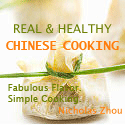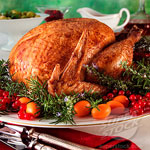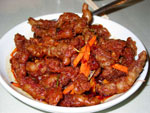| Hi Cookingrecipes, Today I will give you several turkey recipes. I am always
wondering if people outside US also like turkey. In fact,
it's very interesting to talk about what food people like
or dislike. I ever posted a poll on a newsgroup and asked
people what is the food they dislike most. I got dozens of
funny answers like: frog legs, duck, snake, or even dog...
Let us know your opinion.
(One secret: I like eating all the above except for dog -
simply because dogs are the most honest friends of human
beings.) Here are your recipes for the week. Chinese Style Roast Turkey
Serves 8 to 10
Ingredients:
6 tablespoons soy sauce
3 tablespoons sugar
2 tablespoons oyster sauce
2 teaspoons five-spice powder
2 cloves garlic, pressed
1 10-12 pound whole turkey
12 scallions, cut up
several sprigs cilantro
* You can find popular Chinese cooking ingredients and cookware at ChineseFoodDIY online store at:
http://www.chinesefooddiy.com/shopping.htm
Directions:
Preheat oven to 325 degrees. Combine first 5 ingredients
and rub over turkey to coat. Pour remaining sauce into
cavity. Add scallions and cilantro. Place turkey in a
roasting pan. Roast 20 minutes per pound, until a meat
thermometer registers 180 degrees. Let stand 15 minutes
before carving.
*Recipes in this newsletter are from Nicholas Zhou's bestselling cookbook "Real and Healthy Chinese Cooking".

http://www.chinesefooddiy.com/cookbooks.htm
Quick and Easy Turkey Stir-Fry
Ingredients:
1 lb turkey breast, cubed
2 tablespoons dark soy sauce
1 teaspoon sugar
3 cups Oriental blend frozen vegetables
3 - 4 tablespoons Kikkoman Stir-fry Sauce
2 tablespoons oil
Directions:
Marinate the turkey in the dark soy sauce and sugar. Heat
wok and add oil, drizzling down the sides to coat the wok.
Add the turkey and stir-fry for about 3 minutes or until the
meat changes color. Remove and set aside.
Add frozen vegetables to the wok and begin stir-frying. Add
the sauce, and stir-fry until the vegetables are tender but
not overcooked. Add the turkey, heat through, and serve hot
over rice.
Roast Turkey
Ingredients:
1 16 pound (about 7.5 kg) turkey
Marinade:
4 tablespoons hoisin sauce
2 tablespoons soy sauce
2 tablespoons oyster sauce
4 tablespoons honey
2 teaspoons salt
6 - 8 garlic cloves, crushed
Directions:
Mix the marinade ingredients and rub over the turkey. Do
not stuff. Place in the oven with a tray filled with water
underneath. Cook at 375 degrees F. for approximately 3 hours
or according to directions.
Ginger Beef
(The staple dish of Chinese take-out restaurants)
Ingredients:
1 pound beef (rouladen)
1 celery stalk
1 carrot
3 hot chili peppers
2 Tbsp fresh ginger, minced
2 cloves garlic, minced
1 tsp sesame oil
Marinade:
2 Tbsp dark soy sauce
1 Tbsp cooking wine
1 tsp sugar
2 Tbsp ginger juice
1 egg white, lightly beaten
1/4 cup water
1/4 cup flour
1/4 cup cornstarch
1 Tbsp hot chili oil (optional)
Sauce:
1 Tbsp wine
2 Tbsp light soy sauce
1 Tbsp vinegar
4 Tbsp sugar (can substitute brown sugar or honey, if desired)
1/2 tsp sesame oil
2 Tbsp water
chili oil or chili powder to taste
4 to 5 cups oil for deep-frying
1 Tbsp oil for stir-frying
Directions:
Cut beef into matchstick strips, cutting along the grain.
(The meat is easier to cut if it is partially frozen).
To make ginger juice for marinade, peel and grate ginger.
Squeeze out juice.
Mix four marinade ingredients. Add to beef and marinate
for 30 minutes.
Begin preparing vegetables. Cut carrots, celery, and pepper
into thin strips. Mince garlic. For ginger, use the leftover
minced ginger from the preparation of ginger juice.
Mix the sauce ingredients. Set aside.
Beat the egg white and add water. Add flour and cornstarch.
Mix the batter thoroughly. Drop the batter into the marinated
meat.
Heat wok. When heated, add 4 - 5 cups of oil. When the oil
is ready, add about 1/4 of the meat/batter mixture. Deep-fry
the beef until golden brown. Remove and set aside. Let oil
come back to original temperature and add more meat.
When meat is cooked, clean the wok. Heat and add 1 tablespoon oil. When oil is ready, add the vegetables and begin stir-frying. Pour in the sauce and let come to a boil. Add the deep-fried beef. Toss quickly, and remove.
Sprinkle with sesame oil and serve hot.
Peppery-Hot Pork Slices
Ingredients:
9 oz (250 g) lean boneless pork
1/4 cup meat stock
1 egg whit, beaten slightly and mixed with a little flour into a paste
2 cups (500ml) vegetable oil for deep-frying; uses about 5 oz (150ml)
1/4 tsp. salt, or to taste
3 1/2 oz (100g) Chinese cabbage hearts ( bok choy), sliced
1 tbsp hot soybean paste
1/2 tsp. Sichuan peppercorns , crushed
1 tbsp soy sauce
1 tbsp hot chili (chilli) oil
1/4 tsp. sugar
2 tsp. sesame seeds, roasted and ground
1/2 tsp. fresh ginger, chopped
1/4 tsp. MSG (optional)
1 1/2 tsp. cornstarch (corn flour) dissolved in 1 1/2 tsp. water
Directions:
1. Cut the pork into slices about 2 inches by 1/8 inch
(5 cm by 26mm by 4mm). Mix with the egg white paste and 1/8 tsp. of the salt. Set aside.
2. Mix the soy sauce, sugar, ginger, MSG, cornstarch, and
stock into a sauce and set aside.
3. Heat 2 tbsp of the oil in a wok to moderately hot, add
the cabbage and 1/8 tsp. salt, stir-fry until cooked.
Remove, drain, and set aside.
4. Add the rest of the oil to the wok and heat it to about
230oF (110oC) . Add the pork slices, stirring to keep them
from sticking together. Cook until done, remove, and drain
well.
5.Pour the oil out of the wok and reheat it. Add the
peppercorns and soybean paste and stir-fry until the peppercorns turn purplish-red. Add the pork, sauce, chili oil,
and ground sesame seed, and stir-fry until the sauce thickens.
Pour the meat and sauce over the cabbage hearts and serve.
Cooking Tips: The Five Elements Theory of Chinese Cooking
 "He that takes medicine and neglects diet, wastes the skills "He that takes medicine and neglects diet, wastes the skills
of the physician." - Chinese proverb
Like the concept of yin and yang, the Five Elements Theory is at the cornerstone of Chinese culture. What is the Five Elements Theory? The Chinese believe that we are surrounded by five energy fields: wood, fire, earth, metal, and water.
However, the elements are not static: they are constantly
moving and changing. (In fact, some scientists think the
term "element" is misleading, and prefer to refer to the
"five phases" or "five forces.")
Once the Chinese identified the five elements, they set
about categorizing all phenomena within the five categories.
Everything, from a river to sounds to the organs in our
bodies, can be described in terms of the five elements.
How things are characterized depends on their individual
qualities. For example, earth is associated with growth
and nourishment, so the spleen, which monitors the blood -
digesting debris and producing antibodies when necessary -
is categorized as an earth element.
Just as an imbalance between yin and yang can produce
destructive forces, keeping all elements in balance
promotes harmony both in our surroundings and ourselves.
Of course, balancing five elements is a little more
complicated than achieving harmony between two opposing
forces. According to Chinese belief, each element acts
upon two others, either giving birth to it or controlling
it. For example, wood gives birth to fire and controls or
suppresses earth. Similarly, fire gives birth to earth and
controls metal. All the elements are constantly interacting
with other elements - none stand alone. The table below
outlines the relationships.
| Gives Birth To | Controlling | | Wood - Fire | Wood - Earth | | Fire - Earth | Earth - Water | | Earth - Metal | Water - Fire | | Metal - Water | Fire - Metal | | Water - Wood | Metal - Wood |
To give an example from nature, a plant (wood) grows when
it is given water. When burnt, wood gives birth to fire,
and the burnt ashes subsequently return to the earth.
What role does the Five Elements Theory Play in the
Chinese diet?
You'll see adherence to the five elements theory in many
facets of Chinese life. Martial arts, for example: many
schools have a series of basic movements, each designed
to keep the body in harmony with one the elements. And
the five elements theory plays a large role in Feng Shui,
the latest trend in both landscaping and interior
decorating. Literally meaning "wind and water," Feng Shui
is all about aligning energies in your home or work
environment in a way that is most conducive with your own
personal energy.
As for diet, Chinese herbalists believe that, to properly
treat a patient, you must know the state of the five
elements in their body. A deficiency or an excess of an
element can lead to illness. In The Chinese Kitchen: Recipes,
Techniques, Ingredients, History, and Memories from
America's Leading Authority on Chinese Cooking, Eileen
Yin Fei-Lo provides some wonderful examples of how her
grandmother used the principles of the five elements theory
to cure common illnesses. Treating a cough with winter
melon tea and fresh water chestnuts is just one example.
A detailed look at the use of five elements theory in
diagnosing and treating illnesses is beyond the scope
of this article. Suffice to say that practitioners of
traditional Chinese medicine rely on it to explain the
relationships between the body organs and tissues, as
well as between the body and the outside environment.
The table below outlines the relationship between the
five elements and body parts, feelings, colors, and
taste.
| Element | Yin | Yang | Feelings | Colors | Tastes | | Wood | Liver | Gall Bladder | Rage | Green | Sour | | Fire | Heart | Small Intestine | Happiness | Red | Bitter | | Earth | Spleen | Stomach | Thought | Yellow | Sweet | | Metal | Lungs | Large Intestine | Sorrow | White | Spicy | | Water | Kidneys | Bladder | Fear | Black | Salty |
How would a physician use the above information to make a
diagnosis? Let's say a patient suddenly developed a preference for sour food. This could indicate liver problems. Of course, the actual process of examining a patient and making a diagnosis is much more complex than merely consulting a chart. It requires a thorough understanding of the interaction between all the elements. Because time and date of birth are also thought to play a role in an individual's "state of the five elements," many physicians will consult astrological charts before making a diagnosis.
It's always great to talk about food, what will be our next dinner? Let's see!
Cookingrecipes, please tell your friends about us. They will thank you :-) Just click this link to send them an email:
http://www.chinesefooddiy.com/recommend.htm
or forward this email to them. Thank you!
All the best,
Happy cooking!

Nicholas Zhou - Author
Real and Healthy Chinese Cooking 
http://www.chinesefooddiy.com |